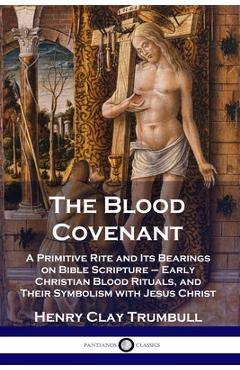The Blood Covenant: A Primitive Rite and Its Bearings on Bible Scripture - Early Christian Blood Rituals, and Their Symbolism with Jesus C - Henry Clay Trumbull

Detalii The Blood Covenant: A Primitive
libris.ro
96.57 Lei
107.3 Lei
Literary Collections
Henry Clay Trumbull
The Blood Covenant: A Primitive - Disponibil la libris.ro
Pe YEO găsești The Blood Covenant: A Primitive de la Henry Clay Trumbull, în categoria Literary Collections.
Indiferent de nevoile tale, The Blood Covenant: A Primitive Rite and Its Bearings on Bible Scripture - Early Christian Blood Rituals, and Their Symbolism with Jesus C - Henry Clay Trumbull din categoria Literary Collections îți poate aduce un echilibru perfect între calitate și preț, cu avantaje practice și moderne.
Preț: 96.57 Lei
Caracteristicile produsului The Blood Covenant: A Primitive
- Brand: Henry Clay Trumbull
- Categoria: Literary Collections
- Magazin: libris.ro
- Ultima actualizare: 08-04-2025 01:30:25
Comandă The Blood Covenant: A Primitive Online, Simplu și Rapid
Prin intermediul platformei YEO, poți comanda The Blood Covenant: A Primitive de la libris.ro rapid și în siguranță. Bucură-te de o experiență de cumpărături online optimizată și descoperă cele mai bune oferte actualizate constant.
Descriere magazin:
The early history of Christianity was marked by blood covenants - rituals involving the blood of believers or animals, which was used to bond worshippers and to symbolize the life of Jesus. Use of blood in religious rites and ceremonies has a long history, with examples present in the Middle East and Africa, and even in parts of Europe. While many of these practices pertained to ancient pagan beliefs - for instance between believers in the Norse God Odin - some instances of the blood covenant are Jewish in origin. Early Christian groups, in particular the Gnostics who worshipped Christ in a clandestine manner in Rome, are considered to have partaken in blood covenants to a limited extent. The notion of a blood covenant between two believers was as a bond between them; the strength of this bond was increased further by the symbolic presence of blood in the life of Jesus. However, knowledge of the practice reached the enemies of Jews and early Christians, who exaggerated the ceremonial use of blood as justification for religious persecutions. Henry Clay Trumbull was a Christian minister and author who had access to a wide range of sources; the fact that the blood covenant had hitherto been overlooked by scholars of Christianity spurred him to publish this book.

Produse asemănătoare

The Blood Covenant Of Jesus Christ: The Power That is in His Blood - Lizzie Ducking
![]() libris.ro
libris.ro
Actualizat in 08/04/2025
77.84 Lei

Blood Alliance: The Attack on Yeshua\'s Threshold Covenant, and Its Impact on You in the Midst of Our Prophetic Times - Zev Porat
![]() libris.ro
libris.ro
Actualizat in 08/04/2025
193.93 Lei

The Blood Covenant: The Hidden Truth Revealed at the Lord\'s Table - E. W. Kenyon
![]() libris.ro
libris.ro
Actualizat in 08/04/2025
83.65 Lei

Blood Covenant: The Story of the Mafia Prince Who Publicly Quit the Mob and Lived - Michael Franzese
![]() libris.ro
libris.ro
Actualizat in 08/04/2025
139.45 Lei

Their Blood Rite: Book One of the Crimson Covenant series - M. J. Lawrie
![]() libris.ro
libris.ro
Actualizat in 08/04/2025
108.12 Lei
